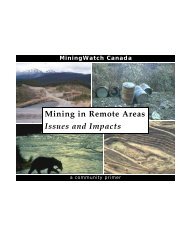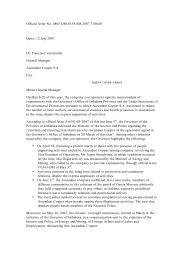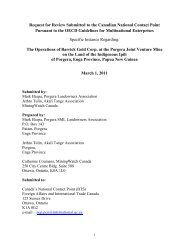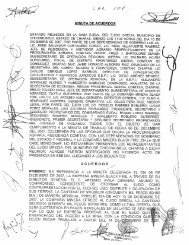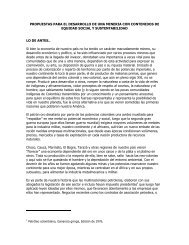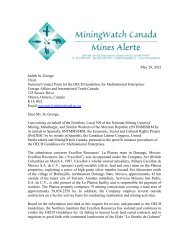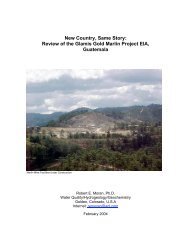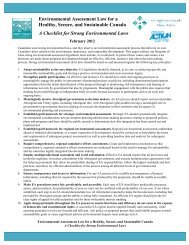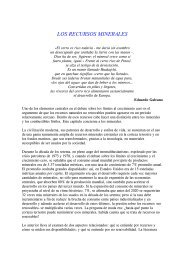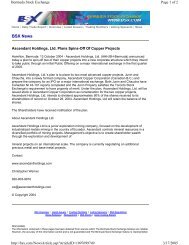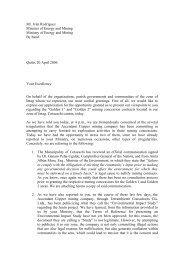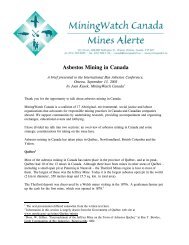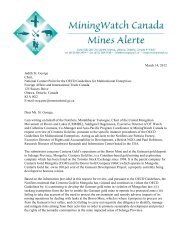Environmental Aspects of Phosphate and Potash Mining
Environmental Aspects of Phosphate and Potash Mining
Environmental Aspects of Phosphate and Potash Mining
- No tags were found...
You also want an ePaper? Increase the reach of your titles
YUMPU automatically turns print PDFs into web optimized ePapers that Google loves.
Extraction<strong>Environmental</strong> <strong>Aspects</strong> <strong>of</strong> <strong>Phosphate</strong> <strong>and</strong> <strong>Potash</strong> <strong>Mining</strong>reducing the need for more intrusive exploration techniques.ConstructionConstruction activities have significant potential tohave adverse environmental impacts. During thisphase, <strong>of</strong>ten a large transient workforce is employed,workforce numbers tend to peak <strong>and</strong> material <strong>and</strong>equipment movements tend to be large. Impacts aretypically related to l<strong>and</strong> disturbance caused by earthworks,air emissions from dust, noise from equipment<strong>and</strong> construction activities <strong>and</strong> heavy volumes <strong>of</strong> trafficon access roads.In many cases, specialized third party companies <strong>and</strong>consultants conduct mine construction activities.‘Turn key’ construction contracts are commonlyawarded. The ability <strong>of</strong> the mine site's owner to controlenvironmental impacts can be maintained tosome extent by considering potential issues <strong>and</strong>explicitly addressing them in the drafting <strong>of</strong> the tender<strong>and</strong> contract.3.3 ExtractionSurface mining methods, by nature, tend to affect awide area <strong>of</strong> l<strong>and</strong> <strong>and</strong> could result in a variety <strong>of</strong>effects such as: l<strong>and</strong> surface disturbance, contaminationor depletion <strong>of</strong> ground <strong>and</strong> surface water, <strong>and</strong> areduction in air quality. Currently, most phosphaterock <strong>and</strong> a small quantity <strong>of</strong> potash ore are sourcedusing surface mining.Figure 3.3.1Potential environmental effects : ore extractionOverburden removalor orebody accessOre extractionL<strong>and</strong> surface disturbanceWater contaminationWater table loweringAir emissionsTopsoil degradationVegetation <strong>and</strong> wildlifedisruptionNoise <strong>and</strong> vibrationmay become contaminated or deplete overlyingaquifers. Underground mining methods are used tosource potash ore from deeply buried marine evaporitepotash deposits. A lesser quantity <strong>of</strong> phosphaterock is sourced using underground methods.L<strong>and</strong> Surface DisturbanceExtraction activities disturb the l<strong>and</strong> surface throughclearing <strong>of</strong> vegetation, removal <strong>of</strong> topsoil, excavation<strong>of</strong> ore <strong>and</strong> overburden <strong>and</strong> the construction <strong>of</strong> overburdendumps or solar evaporation ponds.Removal <strong>and</strong> stockpiling <strong>of</strong> topsoil for subsequentrehabilitation is carried out at many mining operations.In a number <strong>of</strong> cases, topsoil is removed <strong>and</strong>placed directly on l<strong>and</strong>scaped reclaimed areas. Thisavoids the cost <strong>of</strong> re-transporting topsoil from stockpiles<strong>and</strong> the possible reduction <strong>of</strong> biodiversity.Moreover, close coordination <strong>and</strong> planning is requiredbetween the mining <strong>and</strong> rehabilitation operations toensure that areas are prepared in a timely manner. There-planting <strong>of</strong> small trees from areas to be mined <strong>and</strong>the placement <strong>of</strong> dead trees on rehabilitated areas hasbeen used to accelerate the establishment <strong>of</strong> vegetation<strong>and</strong> provide a wildlife habitat.Generally, overburden (4) is either dumped directlyinto the adjacent mined-out areas or placed in speciallydesigned overburden dumps. On closure, thismaterial is l<strong>and</strong>scaped, covered with a layer <strong>of</strong> topsoil<strong>and</strong> revegetated. These activities are discussed furtherin Section 3.7 “Rehabilitation”.The costs associated with transporting <strong>and</strong> l<strong>and</strong>scapingoverburden are minimized in many cases bydesigning <strong>and</strong> managing overburden dumping operationsso as to ensure that they are placed as close aspossible to the final desired location <strong>and</strong> to the finalshape. Bucketwheel excavator operations are particularlyflexible, allowing selective placement <strong>of</strong> theoverburden in the order <strong>of</strong> extraction <strong>and</strong> the creation<strong>of</strong> a flat final l<strong>and</strong>scape. This has advantages for laterrehabilitation.Underground mining methods tend to create fewerenvironmental problems, the major issue being possiblesurface subsidence. This is induced by the removal<strong>of</strong> extensive flat-lying ore deposits, followed by thesubsequent collapse <strong>of</strong> overlying rock. Some minorenvironmental effects may be associated with the disposal<strong>of</strong> rock removed to access the orebody. Also,ground water inflow into the underground openings(4) The term overburden is usually applied to the barrenmaterial (clay, s<strong>and</strong>, or rock) removed to expose the ore insurface mines. Underground mines produce a far more limitedvolume <strong>of</strong> barren waste rock during excavation <strong>of</strong> theaccess ways such as shafts <strong>and</strong> tunnels. Finally, processingoperations generally produce a number <strong>of</strong> solid wastes such assalt tailings, s<strong>and</strong>s, <strong>and</strong> clays. The term overburden will beapplied to all barren material stripped from the surface toallow the ore to be extracted.



